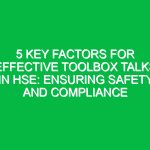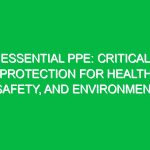Introduction
Personal Protective Equipment (PPE) refers to various equipment worn to minimize exposure to hazards that can cause serious injuries or illnesses in the workplace. In the Health, Safety, and Environment (HSE) domain, PPE examples play a crucial role in safeguarding workers against a multitude of risks, ensuring their well-being while also promoting environmental sustainability. This article explores essential PPE examples relevant to HSE, discussing their significance, benefits, and best practices to create safer work environments.
Understanding PPE in the HSE Context
PPE encompasses a wide range of gear designed to protect individuals from specific hazards. These hazards can be physical, chemical, biological, or ergonomic in nature. Understanding the importance of PPE in the HSE context is vital, as it not only helps prevent workplace injuries but also fosters a culture of safety. By identifying the right PPE examples, organizations can address potential risks and comply with health and safety regulations.
Key PPE Examples for Health, Safety, and Environment
1. Head Protection
Head protection, primarily provided through hard hats, is crucial in industries such as construction, manufacturing, and warehousing. Hard hats protect against falling objects, electrical hazards, and bumps.
- Types of Hard Hats: There are various types of hard hats, including Type I (top impact) and Type II (side impact) helmets. The selection depends on the specific type of risk present in the work environment.
- Real-life Example: In a construction project in New York, a worker fell from a height, but the hard hat he was wearing prevented a severe head injury, demonstrating the importance of proper head protection.
2. Eye and Face Protection
The eyes and face are particularly vulnerable to injuries from flying particles, chemical splashes, and intense light. PPE examples in this category include safety glasses, goggles, and face shields.
- Safety Glasses: These are essential in environments where there is a risk of flying debris. They should meet ANSI Z87.1 standards for impact resistance.
- Goggles: Used when there is a risk of chemical splashes or when working with hazardous materials.
- Face Shields: These provide additional protection for the face and are often used in conjunction with other eye protection.
- Case Study: An incident in a chemical plant highlighted the necessity of face shields when a worker was exposed to a corrosive substance. The face shield prevented severe facial burns.
3. Respiratory Protection
Respiratory hazards can arise from dust, fumes, vapors, and gases. PPE examples include respirators and masks designed to filter out harmful substances.
- Types of Respirators: There are two main types: air-purifying respirators (APRs) and supplied-air respirators (SARs). APRs filter out contaminants from the air, while SARs provide a separate air supply.
- Benefits: Proper respiratory protection can prevent long-term health issues such as respiratory diseases and lung cancer.
- Hypothetical Scenario: In a factory where welding occurs, workers must wear appropriate respirators to avoid inhaling toxic fumes, demonstrating the importance of effective respiratory protection.
4. Hearing Protection
Loud environments can lead to hearing loss over time. PPE examples include earplugs and earmuffs, which reduce exposure to harmful noise levels.
- Earplugs: These are ideal for environments where noise levels exceed 85 decibels.
- Earmuffs: These provide a higher level of protection, particularly in construction sites or manufacturing plants.
- Real-life Example: In a manufacturing facility, workers regularly exposed to high noise levels adopted earmuffs as part of their PPE, significantly reducing cases of hearing impairment.
5. Hand Protection
Hands are often exposed to various hazards, including cuts, abrasions, chemicals, and extreme temperatures. Various types of gloves serve as PPE examples in this category.
- Types of Gloves: Leather gloves protect against cuts; rubber gloves are essential for chemical handling; insulated gloves protect against extreme temperatures.
- Case Study: A food processing plant mandated the use of cut-resistant gloves, resulting in a significant decrease in hand injuries, illustrating the positive impact of proper hand protection.
6. Body Protection
Body protection includes a variety of clothing designed to shield workers from hazards. Examples include coveralls, aprons, and vests.
- Coveralls: Useful in environments with chemical exposure or where workers are prone to cuts and abrasions.
- Aprons: Common in kitchens and laboratories, these protect against spills and splashes.
- High-Visibility Vests: Essential for workers in traffic control or construction sites to ensure they are seen by drivers and machinery operators.
- Personal Insight: During my time working in a manufacturing facility, wearing high-visibility vests helped prevent several near-misses, proving their effectiveness in enhancing safety.
7. Foot Protection
Foot injuries can occur from falling objects, punctures, or slips. Safety footwear, such as steel-toed boots and slip-resistant shoes, are critical PPE examples in this area.
- Steel-Toed Boots: These protect against heavy objects and are essential in construction and warehouse environments.
- Slip-Resistant Shoes: Important for preventing slips and falls, particularly in wet or oily conditions.
- Real-life Example: A worker in a warehouse dropped a heavy box. Thanks to his steel-toed boots, he escaped without injury, highlighting the necessity of foot protection.
8. Fall Protection
Fall hazards are prevalent in construction and maintenance work. PPE examples include harnesses, lanyards, and guardrails.
- Fall Arrest Systems: These systems include a full-body harness, lanyard, and anchor point to prevent falls from heights.
- Guardrails: Installed to prevent falls from edges and are often required by safety regulations in construction sites.
- Case Study: A construction site implementing comprehensive fall protection measures saw a dramatic reduction in fall-related injuries, showcasing the effectiveness of such PPE.
Best Practices for PPE Usage
To maximize the effectiveness of PPE examples, organizations should follow best practices for usage and maintenance:
- Training: Employees should receive proper training on how to use and maintain their PPE effectively.
- Regular Inspections: PPE should be inspected regularly for wear and tear to ensure its protective capabilities.
- Correct Fit: PPE should fit properly to provide the intended protection. Ill-fitting gear can lead to increased risk of injury.
- Encouraging Usage: Create a culture that emphasizes the importance of PPE and encourages employees to report any issues with their equipment.
Regulations and Standards Governing PPE
Various regulations and standards govern PPE usage in the workplace, ensuring that employers provide adequate protection for their employees.
- Occupational Safety and Health Administration (OSHA): OSHA sets forth guidelines and standards for PPE in the workplace. Employers are required to assess hazards and provide appropriate PPE.
- American National Standards Institute (ANSI): ANSI establishes standards for the design, performance, and testing of PPE to ensure its effectiveness.
- European Union PPE Regulation: In the EU, PPE must comply with strict regulations to ensure safety and reliability.
Understanding these regulations helps organizations maintain compliance and protect their workforce effectively.
Conclusion
In conclusion, PPE examples are vital in the HSE domain, protecting workers from a myriad of potential hazards and contributing to a safer work environment. From head protection to fall protection, each category of PPE serves a specific purpose, ensuring the safety of employees in various industries.
By implementing best practices and adhering to regulations, organizations can foster a culture of safety that prioritizes the well-being of their workforce. As we navigate through evolving workplace challenges, embracing the importance of PPE will remain a cornerstone of effective health, safety, and environmental management.
Encouraging ongoing education and awareness around PPE can lead to safer workplaces and a more informed workforce, ultimately benefiting everyone involved.


